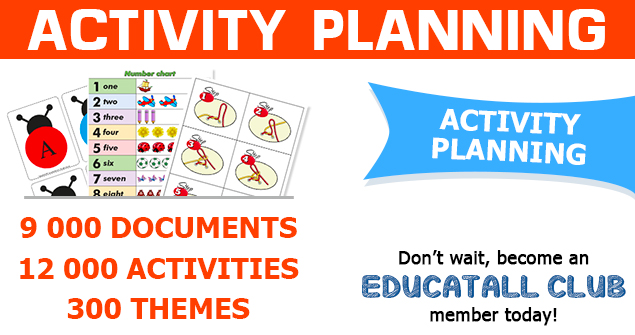Intervention techniques that can be used with young children
(Part 2)
As the days, weeks, and years go by, we tend to use the same intervention techniques over and over again. After all, most of the time, they work well. Furthermore, using these techniques means we don't have to step out of our comfort zone.
In this article, I will suggest a dozen intervention techniques that may be used in a daycare setting. Certain techniques work best in specific situations. Others may work with certain children and not work at all with others. Of course, it is sometimes possible to use more than one technique at the same time.
Trial and error and smiling through it all will make your days spent with little ones enjoyable.
1. Use humor to play down a situation
- This technique is especially useful with 4 and 5 year olds.
- By using humor (yet avoiding sarcasm), the early childhood educator creates a diversion and, at the same time, reduces the level of stress and tension associated to the situation.
- The child does not receive the attention he/she desires and is therefore caught off guard.
2. Emotional participation on behalf of the adult in the child's play
- The early childhood educator demonstrates an interest by integrating the child's play (according to observations made) when a potential conflict occurs.
- This intervention must be used sparingly to avoid creating a dependency where the child always relies on the adult to resolve his/her conflicts.
3. Spontaneous help
- This technique is particularly useful to help an angry child or a child who tends to get frustrated while executing a task. This technique does not help the child learn to tolerate his/her frustration, but it does help avoid repetitive tantrums and disruptions.
- The early childhood educator observes the child closely and offers to help him/her before a tantrum begins. For example, if she realizes that the child is having difficulty cutting, she can offer to lend a hand before he/she gets too frustrated.
4. Establish clear, constant, coherent, concrete, and consequent limit
- The early childhood educator states her expectations as simply and as precisely as she can.
- The early childhood educator must use a vocabulary the child can easily understand within short sentences.
5. Give the child a responsibility/task
- Giving the child a responsibility that is adapted to his/her capacities and interests will increase his/her self-esteem.
- The early childhood educator must positively reinforce the child during the execution of his/her task.
6. Give the child time to execute an action
- This technique is particularly interesting with children who often say "no", argue, or delay executing a task.
- The early childhood educator allows the child to "choose" when he/she will perform a specific task.
7. Motivation chart (rewards, reinforcement)
- Children are sensitive to whatever gives them pleasure. They therefore respond well to rewards.
- Reinforcements can be helpful for stopping negative behavior or encouraging positive behavior.
- There are two main types of rewards:
-
- Material rewards such as stickers, gifts, stars, etc. should be used with moderation to avoid a dependency and expectations. Furthermore, since certain families can't afford to spend on superfluous items, other types of rewards must be considered.
- Social rewards such as hugs, winks, or time spent with the child are based on the adult-child relationship and contribute to the development of a healthy relationship and bond. The child receives the attention he/she desires. This form of reward should be used as often as possible.
8. Reorganizing your space
- Sometimes, simply reducing the amount of available space, physically delimiting play areas with furniture items, or reorganizing your play areas can solve a recurrent behavior problem.
- Proximity among children can lead to conflicts. By observing periods of play, the early childhood educator can determine if the reorganization of the daycare is an interesting intervention option.
9. Restricting and limiting the number of toys available
- This temporary intervention method can help solve certain problems such as a child who takes out several different toys and then refuses to put them away.
- It simply consists of limiting the number of toys available during a certain period to help the child acquire good behavior.
10. The thinking chair/corner/area
- This intervention technique is to be used when a child's behavior endangers the other children in your group, when the group is highly disorganized due to the behavior of one child, or when other interventions have not been successful.
- It consists of removing the child from the group for a short period (depending on child's age, one minute per year).
- The early childhood educator must help the child verbalize the reason he/she was sent to the thinking chair/corner/area. The early childhood educator must also state her expectations before allowing the child to rejoin the group.
11. Reformulation
- Certain situations occur due to the fact that a child did not listen to instructions in the first place (distraction, lack of interest, etc.).
- The early childhood educator asks the child to repeat the instructions before allowing him/her to join the group.
- To protect the child's self-esteem, this should be done one-on-one with the child (if the problem concerns a single child). The early childhood educator may also ask the child to repeat the instructions for the entire group, as long as she remembers to congratulate the child afterwards.
12. Model
- The early childhood educator must always act as a model for the children in her group.
- The early childhood educator can suggest different ways of accomplishing a task and remain by the child's side for support.
- The child learns with the early childhood educator's help. The early childhood educator progressively removes herself to allow the child to pursue his/her social development through a variety of learning opportunities.
Educatall.com is not responsible for the content of this article. The information mentioned in this article is the responsibility of the author. Educatall.com shall not be held responsible for any litigation or issues resulting from this article.

 Home
Home Theme activities
Theme activities
 Babies and toddlers
Babies and toddlers
 Arts and crafts
Arts and crafts
 Science
Science
 Creative recipes
Creative recipes
 Tips and tricks
Tips and tricks
 Special needs
Special needs
 Extra activities
Extra activities
 Educ-TV
Educ-TV
 Newsletter
Newsletter  Online store
Online store Educatall club
Educatall club

